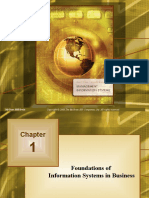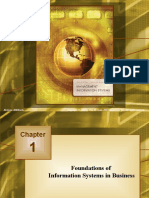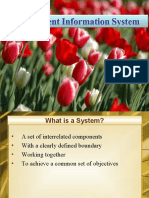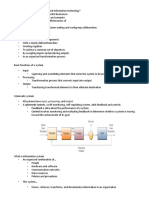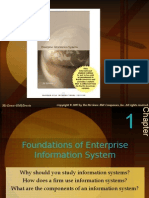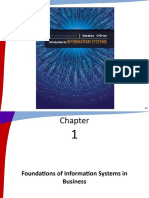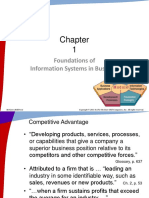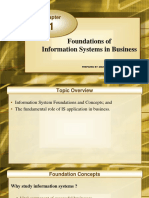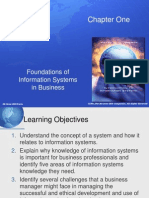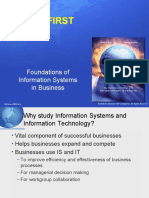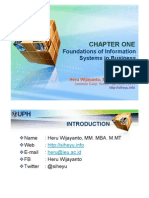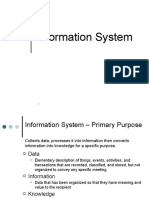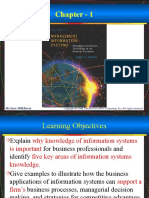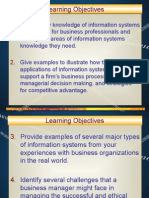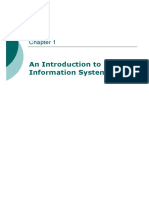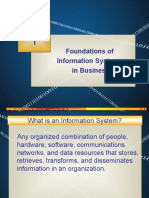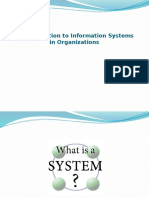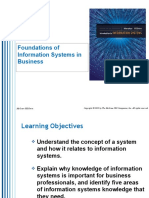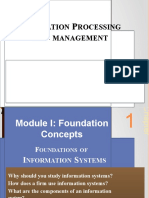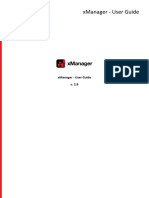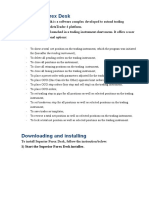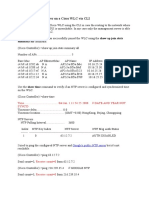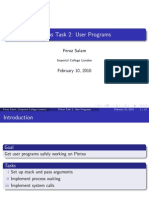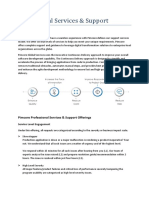MIS
Foundations of Information Systems in Business
McGraw-Hill/Irwin
Copyright 2008, The McGraw-Hill Companies, Inc. All rights reserved.
�Foundation Concepts
Why study information systems and information technology? Vital component of successful businesses Helps businesses expand and compete Improves efficiency and effectiveness of business processes Facilitates managerial decision making and workgroup collaboration
�What is a System?
A set of interrelated components With a clearly defined boundary Working together To achieve a common set of objectives
�What is an Information System?
An organized combination of People Hardware and software Communication networks Data resources Policies and procedures This system Stores, retrieves, transforms, and disseminates information in an organization
�Information Technologies
Information Systems All the components and resources necessary to deliver information and functions to the organization Could be paper based Information Technologies Hardware, software, networking, data management Our focus will be on computer-based information systems (CBIS)
�What Should Business Professionals Know?
�Fundamental Roles of IS in Business
�Trends in Information Systems
�What is E-Business?
Using Internet technologies to empower Business processes Electronic commerce Collaboration within a company Collaboration with customers, suppliers, and other business stakeholders In essence, an online exchange of value
�How E-Business is Being Used
�E-Business Use
Reengineering Internal business processes Enterprise collaboration systems Support communications, coordination and coordination among teams and work groups Electronic commerce Buying, selling, marketing, and servicing of products and services over networks
�Types of Information Systems
Operations Support Systems Efficiently process business transactions Control industrial processes Support communication and collaboration Update corporate databases Management Support Systems Provide information as reports and displays Give direct computer support to managers during decision-making
�Purposes of Information Systems
�Operations Support Systems
What do they do? Efficiently process business transactions Control industrial processes Support communications and collaboration Update corporate databases
�Types of Operations Support Systems
Transaction Processing Systems Record and process business transactions Examples: sales processing, inventory systems, accounting systems Process Control Systems Monitor and control physical processes Example: using sensors to monitor chemical processes in a petroleum refinery Enterprise Collaboration Systems Enhance team and workgroup communication Examples: email, video conferencing
�Two Ways to Process Transactions
Batch Processing Accumulate transactions over time and process periodically Example: a bank processes all checks received in a batch at night Online Processing Process transactions immediately Example: a bank processes an ATM withdrawal immediately
�Management Support Systems
What do they do? Provide information and support for effective decision making by managers
Management information systems Decision support systems Executive information systems
�Types of Management Support Systems
Management Information Systems (MIS) Reports and displays Example: daily sales analysis reports Decision Support Systems (DSS) Interactive and ad hoc support Example: a what-if analysis to determine where to spend advertising dollars Executive Information Systems (EIS) Critical information for executives and managers Example: easy access to actions of competitors
�Other Information Systems
Expert Systems Provide expert advice Example: credit application advisor Knowledge Management Systems Support creation, organization, and dissemination of business knowledge throughout company Example: intranet access to best business practices
�Other Information Systems
Strategic Information Systems Help get a strategic advantage over customer Examples: shipment tracking, e-commerce Web systems Functional Business Systems Focus on operational and managerial applications of basic business functions Examples: accounting, finance, or marketing
�IT Challenges and Opportunities
�Measuring IT Success
Efficiency Minimize cost, time, and use of information resources Effectiveness Support business strategies Enable business processes Enhance organizational structure and culture Increase customer and business value
�Developing IS Solutions
�Challenges and Ethics of IT
Application of IT Customer relationship management Human resources management Business intelligence systems Potential Harm Infringements on privacy Inaccurate information Collusion
�Challenges and Ethics of IT
Potential Risks Consumer boycotts Work stoppages Government intervention Possible Responses Codes of ethics Incentives Certification
�Ethical Responsibilities
What uses of IT might be considered improper or harmful to other individuals or society? What is the proper business use of the Internet or a companys IT resources? How can you protect yourself from computer crime?
�IT Careers
Economic downturns have affected all job sectors, including IT Rising labor costs are pushing jobs to India, the Middle East, and Asia-Pacific countries However, IT employment opportunities are strong, with new jobs emerging daily Shortages of IT personnel are frequent The long-term job outlook is positive and exciting
�IT Careers
�IT Careers
Job increases will be driven by Rapid growth in computer system design and related services The need to backfill positions Information sharing and client/server environments The need for those with problem-solving skills Falling hardware and software prices, which will fuel expanded computerization of operations
�The IS Function
The IS function is A major functional area of business An important contributor to operational efficiency, employee productivity, morale, customer service and satisfaction A major source of information and support for decision making A vital ingredient in developing competitive products and services in the global marketplace A dynamic and challenging career opportunity A key component of todays networked business
�System Concepts: A Foundation
System concepts help us understand Technology: hardware, software, data management, telecommunications networks Applications: to support inter-connected information systems Development: developing ways to use information technology includes designing the basic components of information systems Management: emphasizes the quality, strategic business value, and security of an organizations information systems
�What is a System?
A system is A set of interrelated components With a clearly defined boundary Working together To achieve a common set of objectives By accepting inputs and producing outputs In an organized transformation process
�Basic Functions of a System
Input Capturing and assembling elements that enter the system to be processed Processing Transformation process that converts input into output Output Transferring transformed elements to their ultimate destination
�Cybernetic System
All systems have input, processing, and output A cybernetic system, a self-monitoring, selfregulating system, adds feedback and control: Feedback is data about the performance of a system Control involves monitoring and evaluating feedback to determine whether a system is moving toward the achievement of its goal
�A Cybernetic System
�A Business as a System
�Other System Characteristics
If a system is one of the components of a larger system, it is a subsystem The larger system is an environment Several systems may share the same environment Some may be connected via a shared boundary, or interface Types of systems Open Adaptive
�Components of an IS
�Information System Resources
People Resources Specialists End users Hardware Resources Machines Media Software Resources Programs Procedures
�Information System Resources
Data Resources Product descriptions, customer records, employee files, inventory databases Network Resources Communications media, communications processors, network access and control software Information Resources Management reports and business documents using text and graphics displays, audio responses, and paper forms
